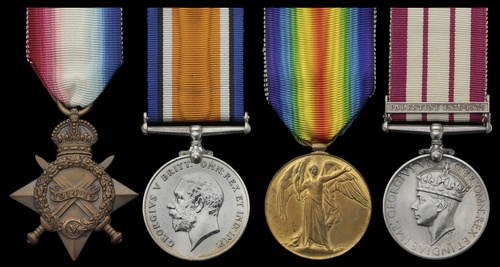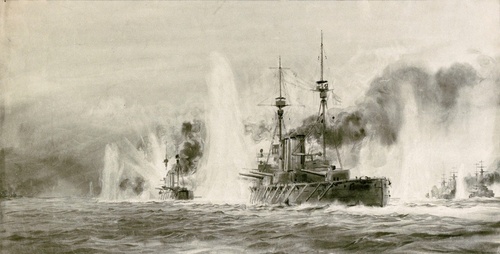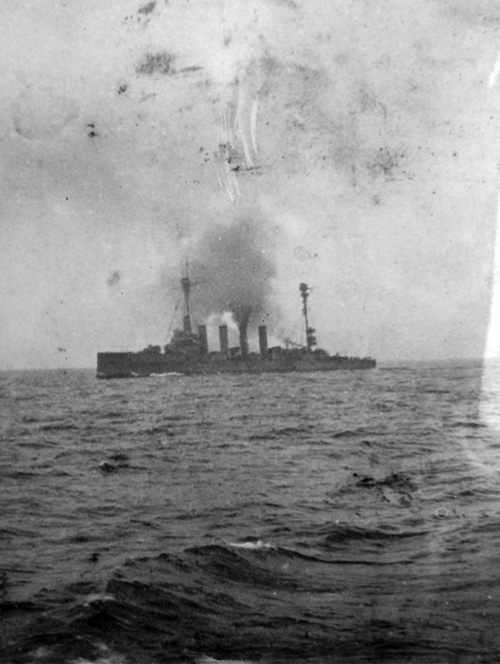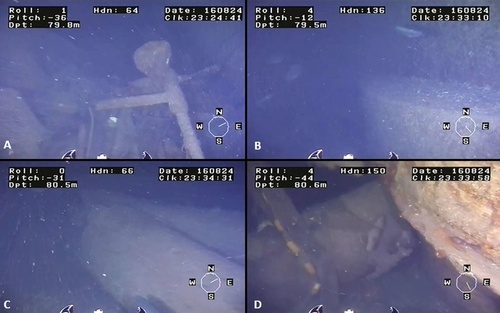Auction: 22003 - Orders, Decorations and Medals
Lot: 366
'A shell came through the upper deck and killed three of my mates working with me - another mate had his leg blown off. After that the firing was so heavy that we could not move around like we should have done. I got hit myself. The sick berth steward tried to bandage me and as he did another shell came and blew off his two middle fingers - they fell on my leg, so I picked them up and gave them back to him as he did not feel what had happened. The only thing he could do now was to tie my trousers over my thigh with my cap ribbon … '
Harrowing scenes aboard the cruiser H.M.S. Warrior at Jutland, as related by Stoker 1st Class David Williams; see Jutland 1916 - Death in Grey Waters, by Nigel Steel and Peter Hart.
A Great War and inter-war Palestine campaign group of four awarded to Lieutenant-Commander W. H. H. Dobson, Royal Navy, who was fortunate to survive the 17-and-a-half minute mauling of H.M.S. Warrior at the Battle of Jutland
1914-15 Star (210005. W. H. H. Dobson. P.O., R.N.); British War and Victory Medal (Gnr. W. H. H. Dobson. R.N.); Naval General Service Medal 1915-62, 1 clasp, Palestine 1936-1939 (Cd. Gnr. W. H. H. Dobson. R.N.), good very fine (4)
William Henry Hamilton Dobson was born in Plymouth, Devon on 25 December 1884 and entered the Royal Navy as a Boy 2nd Class in May 1900. Having gained steady advancement in the interim, he was serving as a Petty Officer in the cruiser H.M.S. Warrior on the outbreak of hostilities in August 1914, in which capacity he was subsequently present at Jutland.
Jutland
On that memorable occasion, Warrior was hit by at least 15 11-inch and six 5.9-inch shells, and suffered a loss of 71 killed, in addition to many wounded. By way of numerous eye-witness accounts, Warrior's ordeal is related in the pages of see Jutland 1916 - Death in Grey Waters, by Nigel Steel and Peter Hart. Her surgeon, Lieutenant Charles Leake, R.N., later wrote:
'In all we had 80 or so killed or died of wounds soon after the action. Having sorted out the wounded as far as possible, it was obvious something more must be done. The wounds were very ragged as caused by pieces of metal. Compound fractures were common and limbs had been torn off. Of the survivors the majority had wounds of the lower extremities. Several had limbs smashed to pulp and had embedded pieces of clothing and metal which needed removal. We commandeered the bathroom near the sick bay as a theatre … We boiled our instruments and set to work. No gloves were served out. These would have been invaluable as in a short space of time one's hands became fearfully sore owing to antiseptic solutions. The Fleet Surgeon operated, assisted by myself, and Dr. MacDonald gave the anaesthetic. We commenced at 9.30 and went on until 5 next morning when one had to cease owing to the fearful tossing of the ship received in the heavy seas. All sorts of wounds were dealt with and several amputations were done - plain circular, no folds. Needless to say several men were beyond hope of recovery and others had died whilst waiting their turn - plainly from shock.'
Later that morning it became clear that the Warrior was in a sinking state and her wounded were brought up on deck. As heavy seas swept across her amidships, the Engadine came alongside to commence embarking her crew and, amidst dramatic scenes - for some men fell between the two ships - a remarkable rescue operation was enacted a record speed.
Signaller H. Y. Ganderton of the Engandine, brings the story to a close:
'Grappling irons and ropes were cast off at 08.25 and gathering speed we left the doomed ship - a truly forlorn spectacle. Derelict, battered and battle scarred, forsaken at last, heaving in a queer dying convulsive sort of manner - and yet, with the white ensign proudly flying at the masthead, her battle ensign. Warrior's crew gave their old ship a cheer, and there were tears in her captain's eyes. That was the last glimpse of the old Warrior we had before she was lost sight of in the mist, and vanished beneath the waves of the cold grey North Sea.'
The day after her sinking, Warrior's captain, Vincent Molteno, wrote to his surviving sailors to commend them on their bravery, noting they had 'behaved magnificently'. He also asked for 10 days' leave so that they could go ashore, see friends and family and be 'cock-a-chest'.
Subsequent career
Dobson came ashore to an appointment in Vivid I and was commissioned as a Gunner R.N. in May 1917, following further service in the battleship Defiance.
Post-War he enjoyed a long and varied career, including periods aboard Revenge and Rodney. An 'extremely hardworking and able officer, respected by everyone on the ship', Dobson was promoted Lieutenant-Commander and placed on the Retired List on 1 April 1937.
Subject to 20% VAT on Buyer’s Premium. For more information please view Terms and Conditions for Buyers.
Sold for
£220
Starting price
£220











